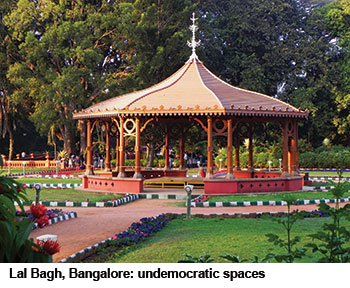 In the public perception, Bangalore (pop.12 million, renamed Bengaluru in 2014 in a fit of foolish sub-nationalism which has jeopardised its international brand as India’s Silicon Valley) is the garden city of India. Ex facie, the statistics are impressive. The charm of this once clean green city which attracted a bevy of the world’s top-ranked IT (information technology) companies including Microsoft, Oracle, IBM, Infosys, TCS, Google and HP among others to establish massive back offices in the city and its suburbs, is its 1,484 public parks, including the 300-acre natural woods Cubbon Park in the heart of the city and its 34 live lakes.
In the public perception, Bangalore (pop.12 million, renamed Bengaluru in 2014 in a fit of foolish sub-nationalism which has jeopardised its international brand as India’s Silicon Valley) is the garden city of India. Ex facie, the statistics are impressive. The charm of this once clean green city which attracted a bevy of the world’s top-ranked IT (information technology) companies including Microsoft, Oracle, IBM, Infosys, TCS, Google and HP among others to establish massive back offices in the city and its suburbs, is its 1,484 public parks, including the 300-acre natural woods Cubbon Park in the heart of the city and its 34 live lakes.
But according to a recent (December 2017) report of the city-based Janaagraha — Centre for Citizenship and Democracy (estb.2001) — one of the country’s most respected NGOs founded by US-returned Swati and Ramesh Ramanathan with the mission to “transform the quality of life in India’s cities and towns” — 21 percent parks are rarely accessible, 97 percent don’t provide drinking water, 44 percent are inadequately lit and 94 percent are bereft of toilets. Janaagraha’s ichangemycity: Bengaluru Parks & Playgrounds survey report which also rates the city’s parks poorly on cleanliness, says that although most parks are manicured and landscaped with walking paths, only 36 percent have play spaces for children.
Moreover despite its nearly 1,500 public parks covering 19.31 sq. km of the city’s 709 sq. km paved roads area, the city’s open spaces fall considerably short of the ideal of the Urban and Regional Development Plan Formulation and Implementation (2015) guidelines of the Union ministry of urban development.
As if to compound the situation, public parks maintained by the Bruhat Bengaluru Mahanagara Palike (BBMP), aka Greater Bangalore Municipal Corporation, are inaccessible to the public for much of every day. They are accessible for nine hours per day from 5-10 a.m in the morning and 4-8 p.m. Typically BBMP officials believe public park timings should suit their employees rather than public convenience. Inevitably, they seem unaware that public parks around the world are open to the public from 6 a.m-10-11 p.m.
“The parks are closed for maintenance in the afternoon. At night, security is a major issue. But, we are now looking at extending timings in the morning for the benefit of the public,” Gangadhar Swamy, deputy director, horticulture, BBMP, magnanimously informed a correspondent of The Hindu (September 19).
Urban ecologists also question the design of public parks, suitable for jogging and walking but failing to provide play spaces for popular team games such as football, hockey and cricket. “Children playing with badminton racquets, cricket bats or a football were a common sight in parks, but one hardly sees that any more. Play spaces for children have vanished from ill-designed public parks,” says Dr. Harini Nagendra, professor of sustainability at the Azim Premji University, Bangalore.
The author of Nature in the City: Bengaluru in the Past, Present and Future (Oxford University Press India, 2016), Nagendra expresses concern about gentrification of public parks which are transforming into undemocratic spaces designed and administered to exclude the poor, differently abled, especially children. “Bangalore is witnessing a gradual privatisation of public spaces. Although in old Bangalore neighbourhood communities are mixed, one rarely sees children from slums playing in their neighbourhood parks. Some parks like the heritage Lal Bagh and Madivala park charge an entry fee, which is unaffordable for the poor. In other parks, subtle invisible exclusion is practised. Strict rules of behaviour, attire, etc are enforced by park managers to exclude underprivileged children and children with special needs from accessing public parks. It’s highly regrettable that children who are already marginalised in so many ways are excluded from public spaces as well,” says Nagendra.
It’s a measure of the extent to which India’s estimated 8,000 cities and towns experiencing a continuous inflow of citizens fleeing the neglected rural hinterland are suffering urban blight and decay, that Bangalore with its 1,484 public parks and 34 live lakes is deficient on so many metrics. Quite clearly, the centrally planned socialist development model which vests civic planning in the omniscient neta-babu brotherhood of ill-educated politicians and venal bureaucrats to the exclusion of NGOs and resident welfare associations, is a dismal failure.
With play spaces for children disappearing in the country’s towns and cities, it’s unsurprising that in the Rio Olympics (2016), the medals tally of India (pop. 1.30 billion) was two — one silver, one bronze.
Sruthy Susan Ullas (Bangalore)























